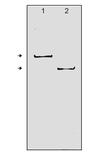Product Details
| Alternative Name: | Poly(ADP-ribose) polymerase-1 |
| |
| Clone: | C-2-10 |
| |
| Host: | Mouse |
| |
| Isotype: | IgG1 |
| |
| Immunogen: | Purified calf thymus poly(ADP-ribose) polymerase (PARP). |
| |
| UniProt ID: | P18493 |
| |
| Source: | Mouse ascites. |
| |
| Species reactivity: | Human, Mouse, Rat
Bovine, Hamster, Monkey
|
| |
| Specificity: | Recognizes an epitope in the C-terminal part of the DNA binding domain of PARP. |
| |
| Crossreactivity: | Does not cross-react with chicken PARP. |
| |
| Applications: | ELISA, IHC, WB
|
| |
| Application Notes: | Detects bands ~116kDa (intact PARP) and ~85kDa (apoptosis-induced cleavage fragment) by Western blot. |
| |
| Formulation: | Liquid. Mouse ascites containing 0.02% sodium azide. |
| |
| Handling: | Avoid freeze/thaw cycles. After opening, prepare aliquots and store at -20°C. |
| |
| Shipping: | Blue Ice |
| |
| Long Term Storage: | -20°C |
| |
| Regulatory Status: | RUO - Research Use Only |
| |

Western blot analysis of whole cell extracts from (1) human HL60 leukemia cells (Prod. No. BML-SW101] and (2) HL60 cells induced to undergo apoptosis using etoposide (Prod. No. BML-SW102). The membrane was probed with C-2-10 mouse monoclonal antibody (Prod. No. BML-SA250) at 1:1000 dilution, secondary antibody was GAMAP (1:2000) and developed with BCIP/NBT. Arrows correspond to 116kDa and 85kDa.
Please mouse over
Product Literature References
The mycotoxin viriditoxin induces leukemia- and lymphoma-specific apoptosis by targeting mitochondrial metabolism: F. Stuhldreier, et al.; Cell Death Dis.
13, 938 (2022),
Abstract;
Differential data on the responsiveness of multiple cell types to cell death induced by non-thermal atmospheric pressure plasma-activated solutions: K. Eto, et al.; Data Brief
36, 106995 (2021),
Abstract;
Full Text
Two experts and a newbie: [18F]PARPi vs [18F]FTT vs [18F]FPyPARP - a comparison of PARP imaging agents: S. Stotz, et al.; Eur. J. Nucl. Med. Mol. Imaging
1007, 259 (2021),
Abstract;
Non-canonical activation of DAPK2 by AMPK constitutes a new pathway linking metabolic stress to autophagy: R. Shiloh, et al.; Nat. Commun.
9, 1759 (2018),
Abstract;
Full Text
Targeting urothelial carcinoma cells by combining cisplatin with a specific inhibitor of the autophagy-inducing class III PtdIns3K complex: D. Schlutermann, et al.; Urol. Oncol.
36, 160.e1 (2018),
Abstract;
Changes in cIAP2, survivin and BimEL expression characterize the switch from autophagy to apoptosis in prolonged starvation: A. Hay-Koren, et al.; J. Intern. Med.
281, 458 (2017),
Abstract;
Cyclic Cystine-Bridged Peptides from the Marine Sponge Clathria basilana Induce Apoptosis in Tumor Cells and Depolarize the Bacterial Cytoplasmic Membrane: A. Mokhlesi, et al.; J. Nat. Prod.
80, 2941 (2017),
Abstract;
Ultraconserved long non-coding RNA uc.63 in breast cancer: A. Marini, et al.; Oncotarget
8, 35669 (2017),
Abstract;
Full Text
Enhanced efficacy of combined HDAC and PARP targeting in glioblastoma: R.D. Rasmussen, et al.; Mol. Oncol.
10, 751 (2016),
Abstract;
Full Text
Novel p53 target genes secreted by the liver are involved in non-cell-autonomous regulation: M. Charni, et al.; Cell Death Differ.
23, 509 (2016),
Application(s): Western Blot,
Abstract;
FK-3000 isolated from Stephania delavayi Diels. inhibits MDA-MB-231 cell proliferation by decreasing NF-κB phosphorylation and COX-2 expression: X. Hu, et al.; Int. J. Oncol.
46, 2309 (2015),
Application(s): Western Blot,
Abstract;
Full Text
Human ACAP2 is a homolog of C. elegans CNT-1 that promotes apoptosis in cancer cells: K.D. Sullivan, et al.; Cell Cycle
14, 1771 (2015),
Abstract;
Full Text
Related Products












